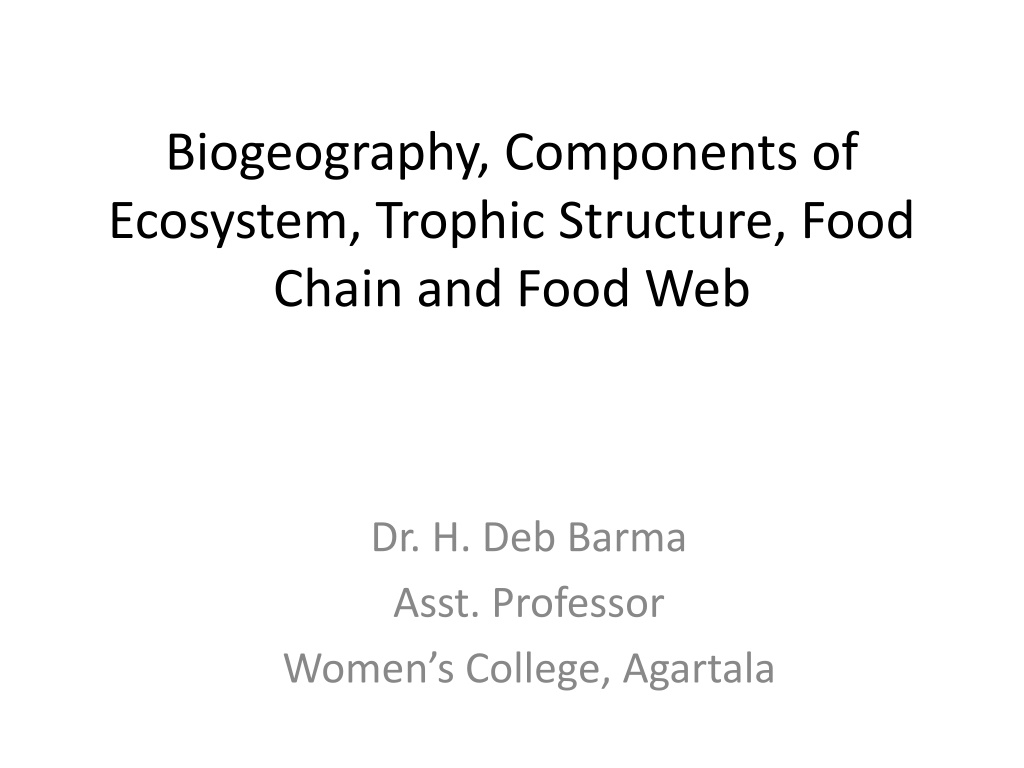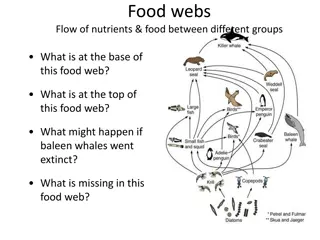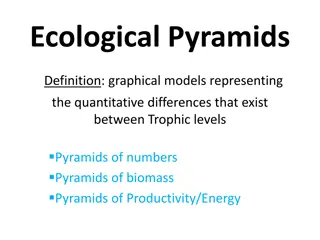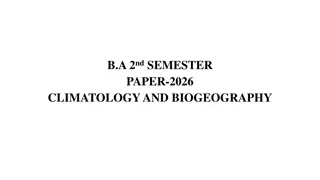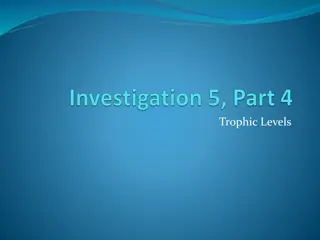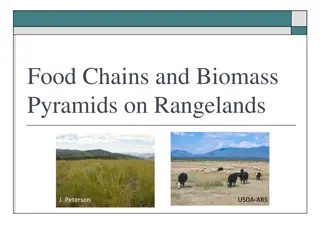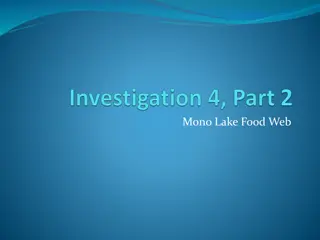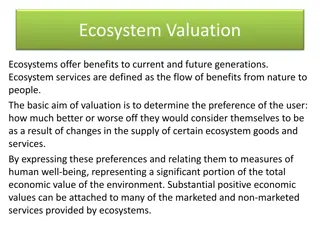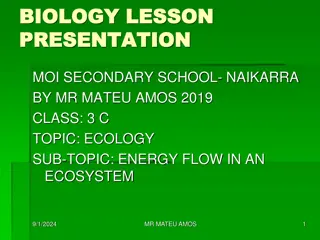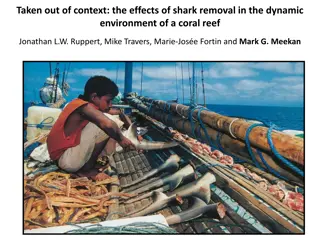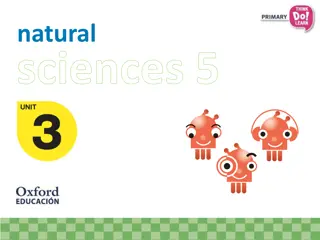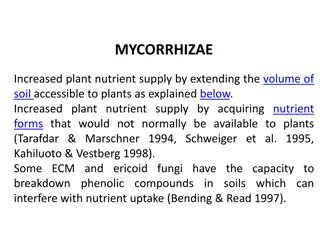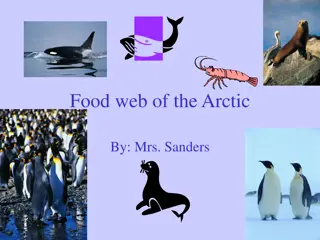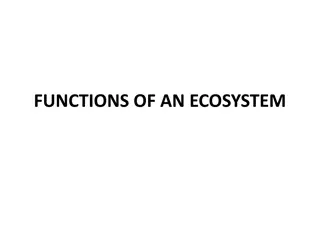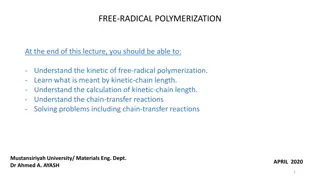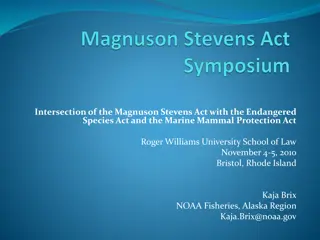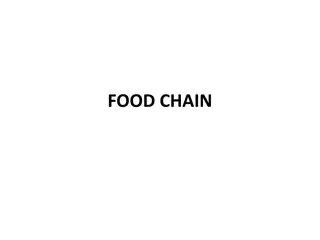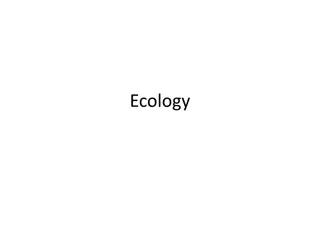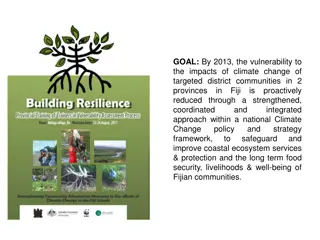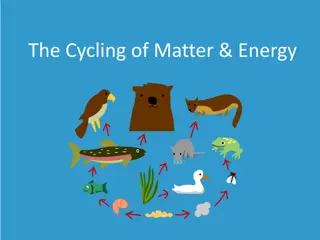Understanding Biogeography, Ecosystem Components, Trophic Structure, Food Chain, and Food Web
Biogeography delves into the origin, distribution, and adaptations of plants and animals, aiding in earth surface differentiation. Ecosystems involve interactions between biotic and abiotic elements, forming trophic structures, biodiversity, and material cycles. Learn about the concepts, definitions, and importance of ecosystems in ecology.
Download Presentation

Please find below an Image/Link to download the presentation.
The content on the website is provided AS IS for your information and personal use only. It may not be sold, licensed, or shared on other websites without obtaining consent from the author. Download presentation by click this link. If you encounter any issues during the download, it is possible that the publisher has removed the file from their server.
E N D
Presentation Transcript
Biogeography, Components of Ecosystem, Trophic Structure, Food Chain and Food Web Dr. H. Deb Barma Asst. Professor Women s College, Agartala
Biogeography Definition: It is an important branch of Physical Geography . It generally studies the origin , distribution, adaptation and association of plants and animals. These plants and animals are also objects of geography because they help to differentiate the earth s surface formed by lithosphere, hydrosphere and lower layer of atmosphere. Branch: Phytogeography and Zoogeography.
Concepts of Ecosystem The term ecosystem was coined in 1935 by the Oxford ecologist Arthur G. Tansley to encompass the interactions among biotic and abiotic components of the environment at a given site. The living and non-living components of an ecosystem are known as biotic and abiotic components, respectively. Ecosystem was defined in its presently accepted form by Eugene Odum as, an unit that includes all the organisms, i.e., the community in a given area interacting with the physical environment so that a flow of energy leads to clearly defined trophic structure, biotic diversity and material cycles, i.e., exchange of materials between living and non-living, within the system .
Concept is much older than the term itself. Parallel terms, used by bio-scientist, such as biocoenosis (Mobius, 1877), microcosm (Forbes, 1887), holocoen (Friederichs, 1930), biosystem (Thienemann,1939), geobiocoenosis (Sukachev, 1944), ecosphere (Cole, 1958), etc. However the term ecosystem now accepted and most preferred, where, eco implies environment, and system means independent, interacting complex.
According to Monkhouse and Small, ecosystem is an organic community of plants and animals viewed within its physical environment or habitat . The total assemblage of components entering into the interactions of group of organism - Strahler. He further elaborated that to the geographer, ecosystem are the part of the physical composition of this life layer .
What is an Ecosystem? An ecosystem, a term very often used in biology, is a community of plants and animals interacting with each other in a given area, and also with their non-living environments. The non-living environments include weather, earth, sun, soil, climate and atmosphere.
Ecosystem is the basic functional unit of ecology. The term ecosystem is coined form a Greek word meaning study of home. Definition: A group of organisms interacting among themselves and with environment is known as ecosystem. Thus an ecosystem is a community of different species interacting with one another and with their non living environment and one another and with their non- living environment exchanging energy and matter. Example: Animals cannot synthesis their food directly but depend on the plants either directly or indirectly
TYPES OF ECOSYSTEM- Natural ecosystem: Natural ecosystems operate themselves under natural conditions. Based on habitat types, it can be further classified into three types. 1. Terrestrial ecosystem This ecosystem is related to land. Example Grassland ecosystem, forest ecosystem, desert ecosystem, etc., 2. Aquatic ecosystem This ecosystem is related to water. It is further sub classified into two types based on salt content. Fresh water ecosystem (i)Running water ecosystems. Examples Rivers, Streams (b) Standing water ecosystems Examples Pond, lake (ii) Marine ecosystem Example : Seas and sea shores
Man made (or) Artificial ecosystems: Artificial ecosystem is operated (or) maintained by man himself. Example Croplands, gardens
The ecosystem relates to the way that all these different organisms live in close proximity to each other and how they interact with each other. For instance, in an ecosystem where there are both rabbits and foxes, these two creatures are in a relationship where the fox eats the rabbit in order to survive. This relationship has a knock-on effect with the other creatures and plants that live in the same or similar areas. For instance, the more rabbits that foxes eat, the more the plants may start to thrive because there are fewer rabbits to eat them.
Ecosystems can be huge, with many hundreds of different animals and plants all living in a delicate balance, or they could be relatively small. In particularly harsh places in the world, such as the North and South Poles, the ecosystems are relatively simple because there are only a few types of creatures that can withstand the freezing temperatures and harsh living conditions. Some creatures can be found in multiple different ecosystems all over the world in different relationships with other or similar creatures. Ecosystems also consist of creatures that mutually benefit from each other. For instance, a popular example is that of the clownfish and the anemone the clownfish cleans the anemone and keeps it safe from parasites as the anemone stings bigger predators that would otherwise eat clownfish.
Ecosystem Structure Each ecosystem has two main components: 1. Abiotic Components The non-living factors or the physical environment prevailing in an ecosystem form the abiotic components. These are Climatic Factors that include rain, temperature, light, wind, humidity etc. and Edaphic Factors including soil, pH, topography minerals etc.
2. Biotic Components The living organisms such as plants, animals and micro- organisms (Bacteria and Fungi) that are present in an ecosystem form the biotic components. The biotic components can be further grouped into two basic components from the nutrition point of view: (i) Autotrophic components, and The autotrophic components include all green plants which fix the radiant energy of the sun and manufacture food from inorganic substances. (ii) Heterotrophic components The heterotrophic components include non-green plants and all animals which take food from autotrophs. Therefore biotic components can be described under following heads.
Producers: Among biotic components, at a basic functional level, ecosystem generally contains primary producers (plants) capable of harvesting energy from the sun through the process called photosynthesis. This energy then flows through the food chain. Consumers: After producers, next come consumers in the ecosystem. There are different classes or categories of consumers; these consumers feed on the captured energy. (a) Consumers of the first order or primary consumers (herbivores): herbivorous are animals that are purely dependent for their food on producers or green plants. Insects, rodents, rabbit, deer, cow, buffalo, goat are some of the common herbivores in the terrestrial ecosystem and small crustaceans, mollusks, etc. in the aquatic habitat.
(b) Consumers of the second order or secondary consumers (carnivores): These are carnivores and omnivores. Carnivores are flesh- eating animals, and the omnivores are the animals that are adapted to consume herbivores as well as plants as their food. Secondary consumers are sparrow, crow, fox, wolves, dogs, cats, snakes, etc. (c) Consumers of the third order or tertiary consumers: These are the top carnivores that prey upon other carnivores, omnivores and herbivores. Lions, tigers, hawk, vulture, etc. are considered as tertiary or top consumers.
(d) Parasites, scavengers and saprobes are also included in the consumers that utilize living tissues or dead remains of animals and plants as their food. Decomposers: Decomposers work at the bottom of the food chain. Dead tissues and waste products are produced at all levels. Scavengers, detritivores (animals that live on the detritus of ecosystems) and decomposers not only feed on this energy but also break organic matter back into its organic constituents. It is the microbes that finish the job of decomposition and produce organic constituents that can again be used by producers.
The energy that flows through the food chain, i.e., from producers to consumers to decomposers is always inefficient. That means less energy is available at secondary consumers level than at primary producers level. It s not surprising, but the amount of energy produced from place to place varies a lot due to the amount of solar radiation and the availability of nutrients and water.
FOOD CHAINS Definition There sequence of eating and being eaten in an ecosystem is known as food chain (or) Transfer of food energy from the plants through a series of organisms is known as food chain When the organisms die, they are all decomposed by microorganism (bacteria and fungi) into nutrients that can again be used by the plants. At each and every transfer, nearly 80-90% of the potential energy gets lost as heat. A food chain always starts with plant life and ends with animal. Herbivores Animal that eat only plants are called herbivores. Carnivores Animals that eat other animals are called carnivores.
https://www.google.com/url?sa=i&url=https%3A%2F%2Fwww.expii.com%2Ft%2Ffood-https://www.google.com/url?sa=i&url=https%3A%2F%2Fwww.expii.com%2Ft%2Ffood- chain-definition-examples- 10318&psig=AOvVaw0eKcZn5ogF7fh1qFytZYhz&ust=1616663335220000&source=images &cd=vfe&ved=2ahUKEwi_r-evysjvAhUeIrcAHeneCToQjRx6BAgAEAc
https://www.google.com/url?sa=i&url=https%3A%2F%2Fin.pinterest.com%2Fpin%2F5123https://www.google.com/url?sa=i&url=https%3A%2F%2Fin.pinterest.com%2Fpin%2F5123 54895113095563%2F&psig=AOvVaw3IwB40PT3dYgJZnLAj3dzA&ust=1616663341063000& source=images&cd=vfe&ved=2ahUKEwjxgMyyysjvAhWZKbcAHTVQB48QjRx6BAgAEAc
Food chain in a pond: Food chain in a forest Tropic Levels (T1,T2, T3, T4, T5) (or) Feeding levels The various steps through which food energy passes in an ecosystem is called as tropic levels. The tropic levels are arranged in the following way as Where , The green plants or producers represent first tropic level T1, The herbivores or primary consumers represent second tropic level T2. The carnivores or secondary consumers represent third tropic level T3. The tertiary consumers are fourth tropic level T4. Finally decomposers represent last tropic level T5
Types of food chain Food chains are classified into two main types: 1. Grazing food chain, 2. Detritus food chain 1.Grazing food chain: Found in Grassland ecosystems and pond ecosystems. Grazing food chain starts with green plants (primary procedures) and goes to decomposer food chain or detritus food chain through herbivores and carnivores. 2.Detritus food chain: Found in Grassland ecosystems and forest ecosystems. Detritus food chain starts with dead organic matter (plants and animals) and goes to decomposer food chain through herbivores and carnivores.
FOOD WEB Definition: The interlocking pattern of various food chains in an ecosystem is known as food web. In a food web many food chains are interconnected, where different types of organisms are connected at different tropic levels, so that there is a number of opportunities of eating and being eaten at each tropic level. Example Grass may be eaten by insects, rats, deer's, etc., these may be eaten by carnivores (snake, tiger). Thus there is a interlocking of various food chains called food webs
https://www.google.com/url?sa=i&url=https%3A%2F%2Fk8schoollessons.com%2Ffood-chains-food-https://www.google.com/url?sa=i&url=https%3A%2F%2Fk8schoollessons.com%2Ffood-chains-food- webs%2F&psig=AOvVaw3Cd1Yxwm0TckL4UEsUxbCV&ust=1616663329242000&source=images&cd=vfe&ved=2ahUKEwiruPqsysjvAhXP_3MB HRZFBdQQjRx6BAgAEAc
Difference between food chains and food web In a linear food chains if one species gets affected (or) becomes extinct, then the species in the subsequent tropic levels are also affected. But, in a food web, if one species gets affected, it doest not affect other tropic levels so seriously. There are number of options available at each tropic level.
Significance of food chains and food webs 1. Food chains and food webs play a very important role in the ecosystem. Energy flow and nutrient 2. cycling takes place through them. 3. They maintain and regulate the population size of different tropic levels, and thus help in maintaining ecological balance. 4. They have the property of bio-magnification. The non biodegradable materials keep on passing from one tropic level to another. At each successive tropic level, the concentration keep on increasing. This process is known as bio-magnification.
Reference https://www.conserve-energy- future.com/what-is-an-ecosystem.php file:///C:/Users/User/Downloads/ecosystem- vss-150708064728-lva1-app6891.pdf
